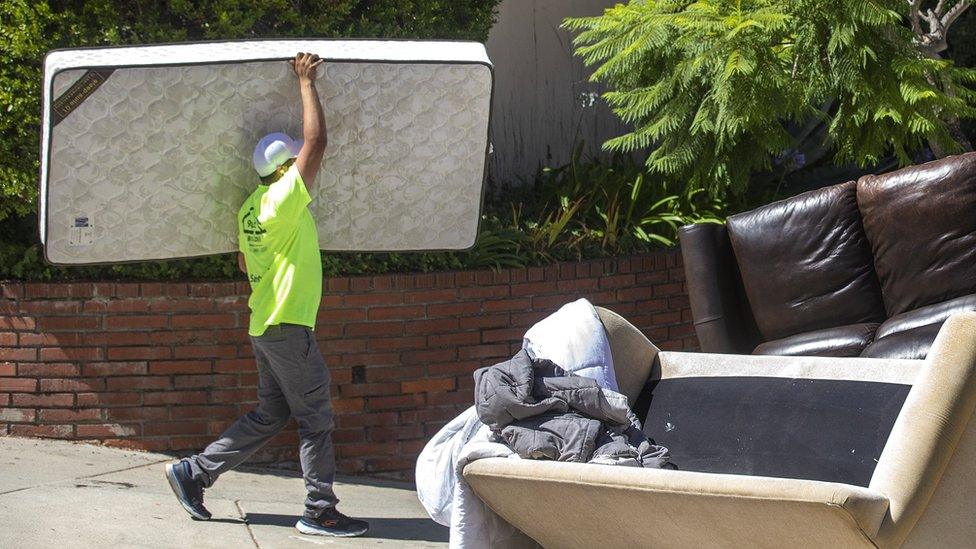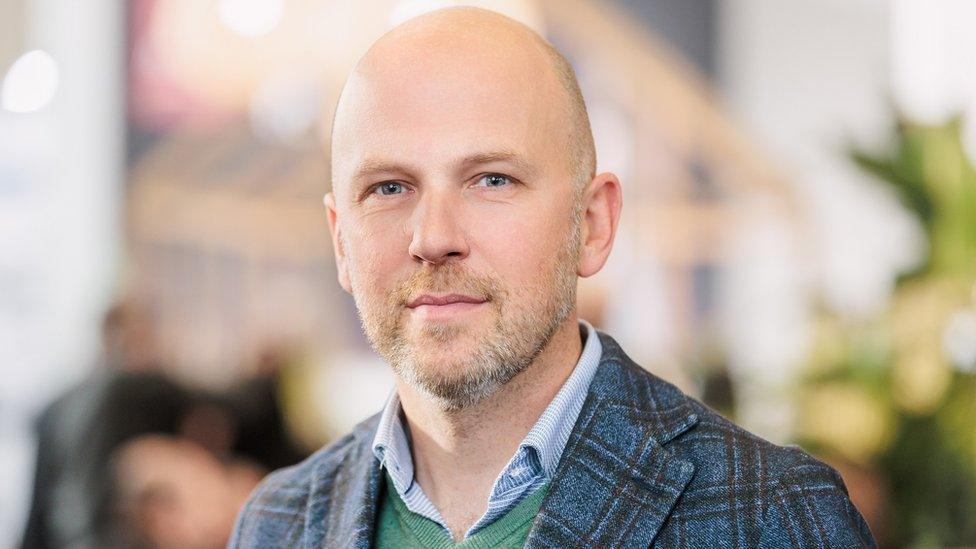Could product passports revolutionise the way we shop?
- Published

Millions of mattresses are thrown away every year
"Every year across Europe, there are about 30 million mattresses that are at the end of their life," says Benjamin Marien. "The vast majority of them end up in landfill or being burned."
Marien is a director at Aquinos Bedding, which makes 1.2 million mattresses per year. The company uses pure polyester covers for most new products because it can be recycled, as opposed to a mix of materials that cannot be separated.
"You see more and more initiatives popping up for dismantling and recycling mattresses," he says. "But that doesn't really help if the dismantler has no idea what the mattress is made of. That's why I'm very excited about the digital product passport."
Digital product passports (DPPs) are being introduced across the EU to improve sustainability. They capture data about the environmental impact of products, their composition, their production and history. Industrial and electric vehicle batteries will be the first products to have mandatory DPPs, from 2027. Other product categories, including textiles, are expected to follow by 2030.
"The European Commission thinks that if the final customer is better informed, they can put pressure on the manufacturer and the distributors [to develop more sustainable products]," says Dr Natacha Tréhan, an expert in procurement and the circular economy at the University of Grenoble Alpes. "It'll increase eco-design. I'm very happy about this because 80% of environmental impact is determined at the design stage."
A number of industry consortia, such as the Global Battery Alliance, are working on developing standards, including defining what should be included in the digital product passport and consistent definitions. "It's impossible to do it alone," says Dr Tréhan. "DPPs are a great example of the need to cooperate not only throughout your supply chain but also with your competitors."

Aquinos plans to tag a million mattresses by 2027 says director Benjamin Marien
Aquinos is introducing digital product passports this year and expects to have one million mattresses tagged by 2027.
The passports will be attached to the mattresses in two ways. There will be a QR code for consumers to scan so they can learn about where the mattress was made and what it was made from. The DPP could also hold warranty and washability information to help extend the product's life. Inside the mattress will be an RFID tag for recyclers to access the passport. It's easier to scan automatically, and it won't fade or get cut off.
To introduce DPPs, Aquinos is working with TripleR, which specialises in digital product passports for bedding, and Avery Dennison, which offers an implementation service including hardware, software, digital ID technology and labels.
"We don't create new information as part of this process," says Michael Goller, senior director for atma.io at Avery Dennison. "We integrate with existing systems."
He adds: "This is not something entirely new: QR codes, RFID and the cloud have been here forever. But applying a combination of technologies to a new problem drives innovation."

Nobody's Child plans to ship all of its products with passports by the end of 2024
Clothing brand Nobody's Child tested digital product passports in its autumn/winter 2023 collection.
That collection used a broad range of suppliers and fabrics, and so gave the firm an opportunity to test the process. The company aims to ship all Nobody's Child products with passports by the end of 2024.
"The legislation lays out that a digital product passport needs to be something that lasts the duration of the lifecycle of the product," says Andrew Xeni, the founder of Nobody's Child.
"At the moment, the best we could get to, which is commercially viable, is a woven label, like a wash care label."
Factories know how to apply it, he adds, and the carrier for the DPP can be a simple QR code. "When you scan it, it takes you to a [web page] which is unique to that individual unit," he says. "Not the style or size, but that actual one in your possession."
Manufacturers will often have multiple suppliers for the same raw materials and components, so items that look alike could have different carbon footprints. The data in the DPP will reflect those differences.
Mr Xeni expects that one day DPP data will have to be officially validated.
"The EU's Corporate Sustainability Due Diligence Directive is going to hold companies accountable for the integrity of the data they're reporting, including the claims on their digital product passports."

Most of the materials that go into 100 Fetter Lane in London will have product passports
For new building 100 Fetter Lane in London, architects Fletcher Priest and engineers Waterman have been asking suppliers to provide information for materials passports. The project, due to be completed this year, uses multiple layers of passports, from materials, through components, to the entire building.
Passports cover structural steel, in-situ and precast concrete, and the raised access floor. Together, they are estimated to account for more than 80% of the building's mass.
"The precast elements on the façade have been designed with bolted connections, which allow them to be easily removed in one piece and reused in a different location, in a different configuration," says Mark Sutton, senior associate, Fletcher Priest Architects.
"At the end of the building's life, the materials are documented in such a manner that it will allow reuse in component form for precast elements and also recycling," he says. "We expect that at that time there will be databases which are widespread and a marketplace for these materials and components."


Circuland is a start-up that aims to create such a marketplace. Its co-founder is Anastasia Stella, who is also associate sustainability consultant for the Fetter Lane project at Waterman.
"By aggregating data from different buildings, there will be a publicly available material stock database to share key benchmarks for types of materials and different typologies of buildings," she says.
"When we have materials in our buildings that we don't need any more, their passports will be sent to the marketplace for used products where you can see their history. When the element is bought and used in another building, the same passport will be used for the new development."

Anastasia Stella wants to create a marketplace for reusing construction materials
As well as supporting better buying decisions and helping with materials recycling, DPPs can support the reuse of products. Jarrod McAdoo is director of product at Ivalua, which provides technology to manage supply chains and procurement. In a previous role, he worked in the power generation sector and was responsible for sourcing discontinued spare parts for critical infrastructure.
"The chance of installing a counterfeit part was always so great," he says.
"Something like a digital passport would have made that process so much easier because you'd be able to see exactly where that part came from."
To make a success of DPPs, he emphasises the need for large companies to support their supply chains. "It's about how the individuals who have resources can help educate some of those lower-level suppliers who, maybe, are willing but don't have the necessary knowledge."